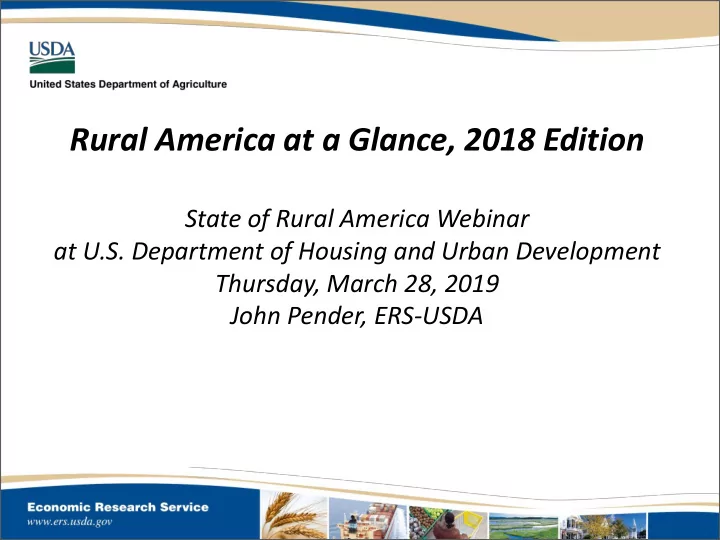

Rural America at a Glance, 2018 Edition State of Rural America Webinar at U.S. Department of Housing and Urban Development Thursday, March 28, 2019 John Pender, ERS-USDA
Rural America at a Glance, 2018 Edition • Released Wednesday, November 7 • Provides an annual summary of demographic and economic trends, with shifting topics that highlight current opportunities and challenges facing rural America • Part of the ERS ‘At a Glance’ series that also includes specialized topics 2
Rural America at a Glance, 2018 Edition Topics this year include: • Population change and components: net migration and natural change • Rural-urban differences in employment growth • Population, employment and poverty trends by race/ethnicity • Aging in rural America Rural is defined in this report as counties outside metropolitan areas. The terms ‘rural’ and ‘ nonmetro ’ are used interchangeably. 3
Rural population trend improving since 2011-12 • Rural America increased its population in 2016-17 after 6 years of population loss • Recent improvement in the rural population growth rate comes from a higher rate of net migration • The rate of natural change continues a long-term downward trajectory, therefore population growth in rural America will increasingly depend on positive net migration. 4
Overall net migration trend masks regional variation Nonmetro counties include 72 percent of the Nation’s land area and 14 percent (46 million) of U.S. residents From 2012-13 to 2016-17: • Over 1,100 rural counties (58 percent) showed positive changes in net migration, with 485 of these switching from net out- to net inmigration • Many rural counties (42 percent) showed a decrease in net migration between 2012-13 and 2016-17. Most are in low- density, remote or high- poverty areas 5
Rural America is less racially and ethnically diverse than urban areas • Whites make up nearly 80 percent of the rural population, compared with 58 percent of the urban population. • Blacks make up 8 percent of the rural population compared with 13 percent in urban areas. • Hispanics are the fastest-growing segment of the rural population but make up just 9 percent of the rural population compared with 20 percent in urban areas. • American Indians are the only minority group with a higher rural than urban share (2 percent versus 0.5 percent). 6
Population trends differ by race/ethnicity • Continued population losses among Whites and Blacks are balanced by population gains among American Indians and Hispanics. • The annual rate of population loss for rural Whites fell from -.44 to -.20, likely due entirely to improving net migration rates. • The Hispanic rate of growth remained near 2 percent per year throughout the period. 7
Employment growth continues to lag in rural areas despite declining unemployment • Rural America includes 14 percent of the Nation’s population but has accounted for only 4 percent of employment growth since 2013. • Rural employment has grown at about 0.5 percent per year since 2010, with periods of stagnation (2012-13 and 2016). • Estimated rural employment in the second quarter of 2018 was still 1.8 percent below its pre-recession level. 8
Why is employment growth slower in rural than in urban counties? Nonmetro employment gains corresponding to falling unemployment were mostly offset by lower labor force participation Nonmetro Metro Change in employment, 2013-17 367,688 9,599,317 corresponding to change in population 22,495 5,934,622 corresponding to change in labor force participation -277,226 -710,489 corresponding to change in the unemployment rate 622,419 4,375,184 Source: Economic Research Service, USDA, using data from the U.S. Census Bureau, American Community Survey, 1-year data. • Rural employment growth has remained low due to slow rural population growth and declining labor force participation. • Rural aging (along with other factors affecting labor force participation) offset 45 percent of the employment growth from falling unemployment. 9
Rural poverty rates declined from 2013 to 2017 • The rural poverty rate (16.4 percent in 2017) has fallen 2 percentage points since reaching its 30-year peak in 2013. • The rural Black population showed the largest decline in poverty but they continue to have the highest poverty rate. • Despite the much lower poverty rate among Whites, the majority of the rural poor (65 percent) are White. 10
Rural America is aging in different ways • 19 percent of the rural population is 65 years or older, compared with 15 percent in urban areas. • Rural counties make up 85 percent of “older - age counties.” • One-third of rural older-age counties are classified by ERS as retirement destinations or having recreation- based economies. • Another third are classified as persistent population-loss counties. 11
Summary • Rural population increased in 2016-17 for the first time this decade. • With natural change projected to continue falling, especially for non-Hispanic Whites, future population growth in rural America will increasingly depend on positive net migration. • Net migration rates are higher in densely-settled rural areas with attractive scenic qualities, or those near large cities. • Aging and other demographic factors are slowing rural employment growth by reducing the size of the potential labor force. • Rural poverty rates are down from a 2013 peak for all race/ethnicity groups. • Retiree inmigration and young-adult outmigration both lead to rural aging, but with distinct regional patterns that reflect differences in rural well-being and economic development prospects. 12
Recommend
More recommend